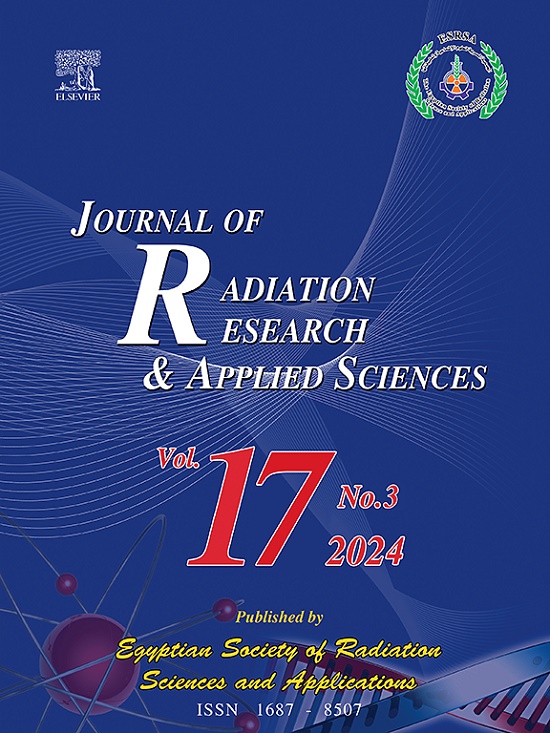Advancing radiation safety in dental CBCT scans: Assessing the efficacy of barium sulfate shields in protecting the thyroid and eyes
IF 1.7
4区 综合性期刊
Q2 MULTIDISCIPLINARY SCIENCES
Journal of Radiation Research and Applied Sciences
Pub Date : 2025-03-31
DOI:10.1016/j.jrras.2025.101474
引用次数: 0
Abstract
Background
Cone beam computed tomography (CBCT) is widely used in dentistry but involves exposure to ionizing radiation, raising concerns about radiation-induced thyroid or eye damage. This study aimed to assess the effectiveness of barium sulfate shields for the thyroid and eye during dental CBCT scans.
Methods
An experimental study measured surface dose in the thyroid and eyes regions during CBCT scans using an anthropomorphic phantom and a solid-state detector. Radiation dose reduction was calculated between radiation surface doses with and without shielding. The significance of the barium sulfate shields was determined using a t-test.
Results
The greatest dose reduction was observed during a complete study with a sinus scan in a field size of 11 × 13 cm2 for the thyroid and eye (91 % and 90 %, respectively). The least dose reduction for the thyroid shield was recorded for the half jaw area in a field size of 8 × 5 cm2 (68 %), while for the eyes, it was found for the whole side, half jaw in a field size of 8 × 8 cm2 (76 %). Statistically significant differences were noted between the findings with and without a shield for both the thyroid (p = 0.0001) and the eyes (p = 0.0000).
Conclusions
Barium sulfate shields effectively reduce the radiation doses to the thyroid and eyes in an adult phantom across six field sizes during dental CBCT. Dose reduction depended on the shield position, imaging area and field size. Findings highlight the importance of these shields in minimising radiation exposure and protecting the thyroid and eyes.
提高牙科CBCT扫描的辐射安全性:评估硫酸钡屏蔽对甲状腺和眼睛的保护效果
锥形束计算机断层扫描(CBCT)广泛应用于牙科,但涉及暴露于电离辐射,引起对辐射引起的甲状腺或眼睛损伤的担忧。本研究旨在评估在牙科CBCT扫描期间硫酸钡屏蔽对甲状腺和眼睛的有效性。方法在实验研究中,使用拟人幻像和固体探测器测量CBCT扫描时甲状腺和眼睛区域的表面剂量。计算了有屏蔽和没有屏蔽的辐射表面剂量之间的辐射剂量减少量。使用t检验确定硫酸钡屏蔽的显著性。结果在一个完整的研究中,在11 × 13 cm2的鼻窦扫描范围内,甲状腺和眼睛的剂量减少幅度最大(分别为91%和90%)。甲状腺屏蔽的最小剂量减少记录为半颌面积为8 × 5 cm2(68%),而对于眼睛,发现整个侧,半颌面积为8 × 8 cm2(76%)。在甲状腺(p = 0.0001)和眼睛(p = 0.0000)的检查结果中,有统计学意义的差异被注意到。结论在牙科CBCT过程中,硫酸钡保护层可有效降低成人幻影甲状腺和眼睛的辐射剂量。剂量减少取决于屏蔽位置、成像面积和视场大小。研究结果强调了这些防护罩在尽量减少辐射暴露和保护甲状腺和眼睛方面的重要性。
本文章由计算机程序翻译,如有差异,请以英文原文为准。
求助全文
约1分钟内获得全文
求助全文
来源期刊

Journal of Radiation Research and Applied Sciences
MULTIDISCIPLINARY SCIENCES-
自引率
5.90%
发文量
130
审稿时长
16 weeks
期刊介绍:
Journal of Radiation Research and Applied Sciences provides a high quality medium for the publication of substantial, original and scientific and technological papers on the development and applications of nuclear, radiation and isotopes in biology, medicine, drugs, biochemistry, microbiology, agriculture, entomology, food technology, chemistry, physics, solid states, engineering, environmental and applied sciences.
 求助内容:
求助内容: 应助结果提醒方式:
应助结果提醒方式:


